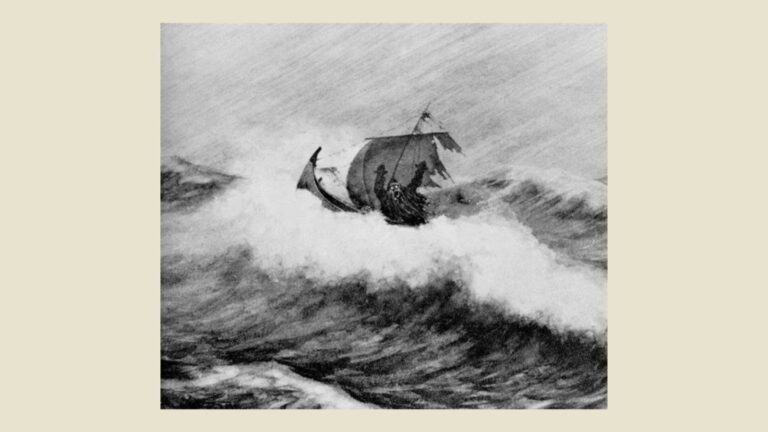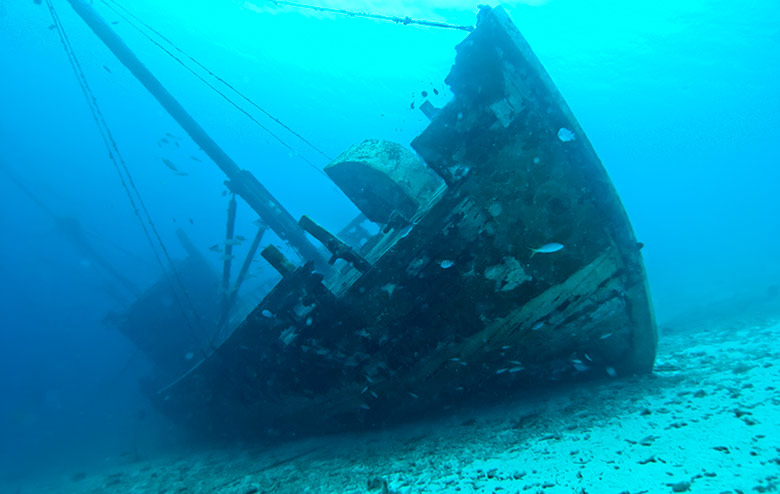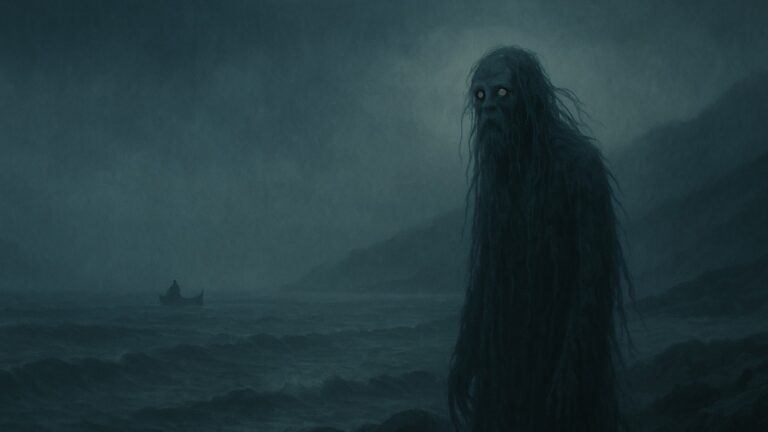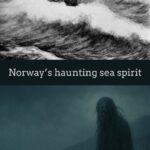Not all Norwegian folk tales are friendly stories of trolls turning to stone or gnomes stirring porridge in forest cabins. Some tales are darker. Far darker.
Along the misty shores of Norway’s rugged coastline, an eerie legend still lingers. It speaks of the Draug, a ghostly figure doomed to haunt the sea, forever tied to stormy nights, shipwrecks, and lost souls.

Long before lifejackets, navigation systems, or reliable forecasts, the sea was a force both generous and terrifying. For Norway’s coastal communities, the ocean offered food, trade, and travel, but it also took lives without warning.
In that context, it’s no surprise that tales of cursed sailors and vengeful sea spirits emerged to fill the gaps left by grief, fear, and the unexplained. One such spirit was the Draug.
Who or What is the Draug?
The Draug, referred to as Draugen in Norwegian, is a creature from Norwegian folklore said to be the restless spirit of a drowned sailor.
While the term has roots in Old Norse, where draugr referred to any kind of undead being, in Norway the legend evolved into something more specific: a ghost of the sea.
Descriptions of the Draug vary depending on where you are in the country, but certain details remain remarkably consistent.
The creature is typically imagined as a decaying, corpse-like figure, bloated by seawater, with seaweed clinging to its tangled hair and beard. Its skin is deathly pale or tinged with green and grey, as if it has never seen sunlight.
In some tales, it rows a half-boat (just the prow) through the fog, the creaking of oars and its echoing moans striking fear into any who hear them.
Wherever it appears, the Draug is a harbinger of doom. Spotting one is said to foretell a shipwreck or the death of a fisherman. In some stories, it actively seeks to sink boats, luring the living to join it beneath the waves.
A Creature Born from the Sea
What makes the Draug one of the most powerful and enduring figures in Norwegian legend is its intimate connection to the sea. While trolls and other mythical beings are tied to forests and mountains, the Draug belongs to saltwater, storms, and shipwrecks.

It’s no coincidence that the most vivid Draug tales come from northern coastal communities, where fishing was not just a job but a lifeline—and a dangerous one at that.
These communities lived with the constant risk of drowning. A sudden squall, an unseen reef, or even a moment’s misjudgement could mean death. Without modern technology, people turned to folklore to explain the unexplainable.
Why did one boat make it home while another vanished without a trace? Perhaps the Draug had claimed it.
The figure of the Draug became not only a symbol of danger and death, but also a warning. In some versions of the legend, it is the ghost of a sailor who acted selfishly or maliciously in life.
This turned the tale into a kind of moral fable: those who die unrepentant at sea may not find peace, and may instead return to wreak havoc upon others.
Kittelsen’s Creepy Creation
The early 20th-century artist Theodor Kittelsen did more than any storyteller to bring the Draug to life—visually, at least. His haunting illustration Draugen, created in 1900, remains one of the most iconic depictions of the creature.
In the image, the Draug rises out of a moonlit sea, its face skeletal, hair wild, and boat half-submerged. There’s a madness in its eyes, and a silence in the water around it.
The composition is deliberately unsettling, tapping into that ancient, primal fear of things that lurk just out of sight.
Kittelsen’s artwork was part of a broader romantic-nationalist movement in Norway, which sought to preserve and elevate the country’s folk traditions. Today, his drawing of the Draug is widely recognised, even if many Norwegians no longer know the full story behind the image.
Modern Appearances and Cultural Legacy
While belief in the Draug has faded from everyday life, the legend continues to echo throughout Norwegian culture.

It appears in literature, from children’s books to darker contemporary fiction, where authors draw on the country’s folklore to build atmosphere and mystery.
In gaming, the 2019 psychological adventure Draugen, set in 1920s Norway, borrows heavily from the myth to create an unsettling mood of isolation and loss.
The Draug also surfaces in more unexpected places. The municipal coat of arms of Bø in Nordland features a stylised half-boat with a mast and square sail. It's an image directly inspired by the Draug’s ghostly vessel.
While the design also symbolises the region’s deep connection to fishing and the sea, its link to folklore shows how such legends continue to influence local identity and symbolism.
In coastal regions like Helgeland, Lofoten, and Vesterålen, the Draug remains a staple of oral storytelling. Museums and cultural centres in these areas often preserve the tales, not out of fear but as a way to honour the storytelling traditions of past generations.
And even today, in the foggy stillness of Norway’s remote fishing villages, you might hear someone recall an eerie sound on the wind or a strange shape glimpsed beneath the waves. Whether meant as entertainment or warning, the story lives on.
Why Draugen Still Matters
The Draug is a legend born not just from superstition, but from lived experience. In a land where nature has always demanded respect, the Draug is a personification of that warning.
It reminds us that the sea is powerful, unpredictable, and not to be taken lightly.
It also reminds us of the human cost of life on the coast. Every family that has lost someone to the sea understands the kind of grief that creates legends. The Draug is, in many ways, the embodiment of mourning. It's a figure who cannot rest, because those left behind can’t forget.
For visitors to Norway, the legend of the Draug speaks to the hardships and fears of generations past, but it also reflects the awe Norwegians still feel toward their dramatic natural environment.
So next time you walk along a foggy pier or stand by a quiet fjord, take a moment to imagine what might rise from those still waters. The past has a way of lingering here, especially when the sea is involved.


